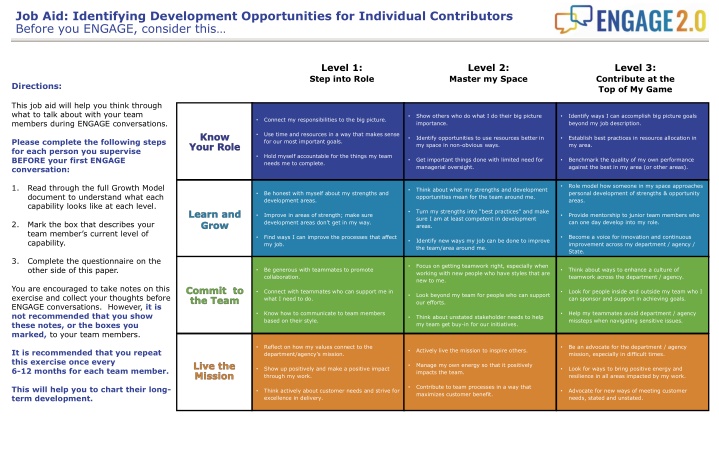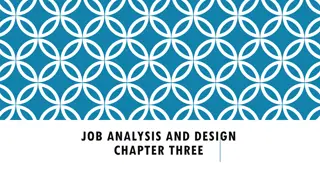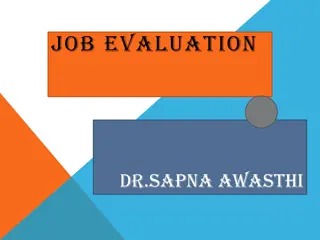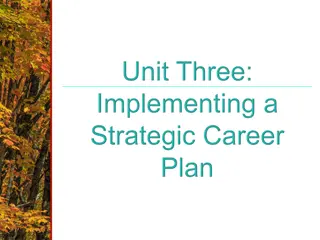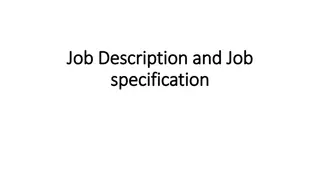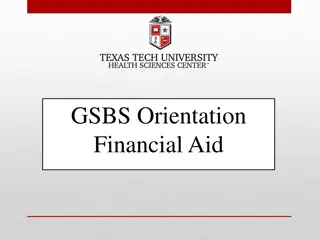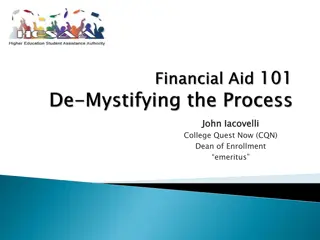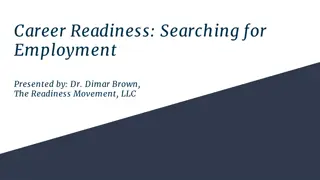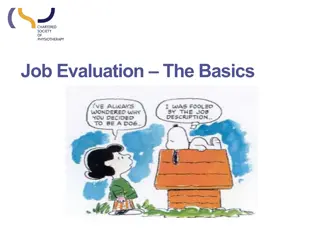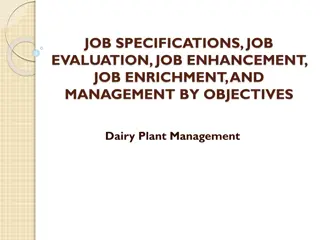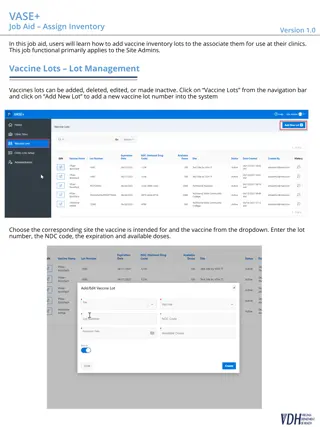Job Aid: Identifying Development Opportunities for Individual Contributors
This job aid provides a structured approach to identifying development opportunities for individual contributors before engaging in conversations about their growth and capabilities. It emphasizes understanding each team member's strengths and areas for improvement, setting goals aligned with the big picture, and fostering a culture of teamwork and continuous improvement within the organization.
Download Presentation

Please find below an Image/Link to download the presentation.
The content on the website is provided AS IS for your information and personal use only. It may not be sold, licensed, or shared on other websites without obtaining consent from the author.If you encounter any issues during the download, it is possible that the publisher has removed the file from their server.
You are allowed to download the files provided on this website for personal or commercial use, subject to the condition that they are used lawfully. All files are the property of their respective owners.
The content on the website is provided AS IS for your information and personal use only. It may not be sold, licensed, or shared on other websites without obtaining consent from the author.
E N D
Presentation Transcript
Job Aid: Identifying Development Opportunities for Individual Contributors Before you ENGAGE, consider this Level 1: Step into Role Level 2: Master my Space Level 3: Contribute at the Top of My Game Directions: This job aid will help you think through what to talk about with your team members during ENGAGE conversations. Show others who do what I do their big picture importance. Identify ways I can accomplish big picture goals beyond my job description. Connect my responsibilities to the big picture. Use time and resources in a way that makes sense for our most important goals. Know Your Role Identify opportunities to use resources better in my space in non-obvious ways. Establish best practices in resource allocation in my area. Please complete the following steps for each person you supervise BEFORE your first ENGAGE conversation: Hold myself accountable for the things my team needs me to complete. Get important things done with limited need for managerial oversight. Benchmark the quality of my own performance against the best in my area (or other areas). Role model how someone in my space approaches personal development of strengths & opportunity areas. 1. Read through the full Growth Model document to understand what each capability looks like at each level. Think about what my strengths and development opportunities mean for the team around me. Be honest with myself about my strengths and development areas. Turn my strengths into best practices and make sure I am at least competent in development areas. Learn and Grow Improve in areas of strength; make sure development areas don t get in my way. Provide mentorship to junior team members who can one day develop into my role. 2. Mark the box that describes your team member s current level of capability. Become a voice for innovation and continuous improvement across my department / agency / State. Find ways I can improve the processes that affect my job. Identify new ways my job can be done to improve the team/area around me. 3. Complete the questionnaire on the other side of this paper. Focus on getting teamwork right, especially when working with new people who have styles that are new to me. Be generous with teammates to promote collaboration. Think about ways to enhance a culture of teamwork across the department / agency. You are encouraged to take notes on this exercise and collect your thoughts before ENGAGE conversations. However, it is not recommended that you show these notes, or the boxes you marked, to your team members. Commit to the Team Connect with teammates who can support me in what I need to do. Look for people inside and outside my team who I can sponsor and support in achieving goals. Look beyond my team for people who can support our efforts. Know how to communicate to team members based on their style. Help my teammates avoid department / agency missteps when navigating sensitive issues. Think about unstated stakeholder needs to help my team get buy-in for our initiatives. Reflect on how my values connect to the department/agency s mission. Be an advocate for the department / agency mission, especially in difficult times. Actively live the mission to inspire others. It is recommended that you repeat this exercise once every 6-12 months for each team member. Live the Mission Manage my own energy so that it positively impacts the team. Show up positively and make a positive impact through my work. Look for ways to bring positive energy and resilience in all areas impacted by my work. Contribute to team processes in a way that maximizes customer benefit. This will help you to chart their long- term development. Think actively about customer needs and strive for excellence in delivery. Advocate for new ways of meeting customer needs, stated and unstated.
Job Aid: Identifying Development Opportunities Before you ENGAGE, consider this After you have thought about your team members capability levels, answer the questions below to think through your approach to their upcoming ENGAGE conversations. 1. Before you even think about their development, what are three things that are important to this person? 3. How self-aware is this person? Are there any blind spots (e.g., development areas they are not aware of)? What are they? 6. What is the area where you think you are most likely to succeed in coaching them to the next level? ____________________________________ _____________________________________ _____________________________________ ____________________________________ _____________________________________ _____________________________________ ____________________________________ _____________________________________ 7. Take a look at some of the pitfalls related to your answers in questions 4-6. Which ones are most likely to be difficult for this person? Which would be easiest? 4. Think of one capability area where they could move a level up if they mastered a strength they already have: 2. How are these things tied to their developmental opportunities? For instance, will they enjoy working on anything specific? Will they want to avoid working on anything? _____________________________________ _____________________________________ _____________________________________ _____________________________________ _____________________________________ _____________________________________ _____________________________________ 5. Think of one capability area where if they moved a level up, it would really enhance their performance: 8. Re-read your answers to the first 7 questions. Based on all of that, where would you start your first ENGAGE conversation? Why? Remember to start with their interests and needs, but add your own ideas from this exercise when it s appropriate. _____________________________________ _____________________________________ _____________________________________ _____________________________________ _____________________________________
Job Aid: Identifying Development Opportunities for Managers Before you ENGAGE, consider this Level 1: Step into Role Level 2: Master my Space Level 3: Contribute at the Top of My Game Directions: This job aid will help you think through what to talk about with your team members during ENGAGE conversations. Understand where all the teams I interact with fit in the big picture. Design the strategy for my entire area. Articulate where my team fits in the big picture. Make decisions that are sure to benefit the entire agency. Know Your Role Make good decisions that make sense for all the teams around me. Make good decisions with team resources. Please complete the following steps for each person you supervise BEFORE your first ENGAGE conversation: Make sure my team accomplishes the most important tasks. Get the agency to deliver against strategically important goals. Get important tasks done through very diverse teams. 1. Read through the full Growth Model document to understand what each capability looks like at each level. Position self and senior talent to leverage strengths and work on key development opportunities. Identify strengths and development opportunities in my team. Build people s insights around their strengths / development areas. Learn and Grow Build the talent of my direct reports. Build talent in professionals who are very different from me. Build a pipeline and bench of talent, especially for senior roles. 2. Mark the box that describes your team member s current level of capability. Drive continuous improvement in how we get things done. Scale improvements to impact change across the department/agency. Facilitate improvement efforts across teams. 3. Complete the questionnaire on the other side of this paper. Shape team processes to draw strength from a range of skills, perspectives, and styles. Embrace different styles and perspectives to build teamwork among my direct reports. Design cross-disciplinary high-performing teams. You are encouraged to take notes on this exercise and collect your thoughts before ENGAGE conversations. However, it is not recommended that you show these notes, or the boxes you marked, to your team members. Ensure your network touches many parts of the dept/agency and includes influential decision- makers. Foster relationships with senior leaders who will support key initiatives over the long-term. Commit to the Team Create a solid network inside and outside your team. Navigate the competing needs of senior colleagues to gain buy-in at the highest levels. Influence team members based on what s important to them. Adapt your style of persuasion based on subtle differences between audiences. Role model my values in a way that diverse groups would respect and appreciate. Role model my values for my team in a way that connects with the department/agency s purpose and mission. Act as a figurehead for the department/ agency s mission. It is recommended that you repeat this exercise once every 6-12 months for each team member. Encourage the efforts of people who are motivated by things that are different from what motivates me. Live the Mission Inspire and motivate team members to meet the department/agency s most challenging goals. Show my team I value their efforts and foster a positive team environment. Ensure the department/agency is easily recognized for consistently delivering needed services to all customer groups. This will help you to chart their long- term development. Drive focus on customer outcomes through professionals who meet a range of customer needs. Foster ownership of team commitments to customers and deliver needed services reliably.
Job Aid: Identifying Development Opportunities Before you ENGAGE, consider this After you have thought about your team members capability levels, answer the questions below to think through your approach to their upcoming ENGAGE conversations. 1. Before you even think about their development, what are three things that are important to this person? 3. How self-aware is this person? Are there any blind spots (e.g., development areas they are not aware of)? What are they? 6. What is the area where you think you are most likely to succeed in coaching them to the next level? ____________________________________ _____________________________________ _____________________________________ ____________________________________ _____________________________________ _____________________________________ ____________________________________ _____________________________________ 7. Take a look at some of the pitfalls related to your answers in questions 4-6. Which ones are most likely to be difficult for this person? Which would be easiest? 4. Think of one capability area where they could move a level up if they mastered a strength they already have: 2. How are these things tied to their developmental opportunities? For instance, will they enjoy working on anything specific? Will they want to avoid working on anything? _____________________________________ _____________________________________ _____________________________________ _____________________________________ _____________________________________ _____________________________________ _____________________________________ 5. Think of one capability area where if they moved a level up, it would really enhance their performance: 8. Re-read your answers to the first 7 questions. Based on all of that, where would you start your first ENGAGE conversation? Why? Remember to start with their interests and needs, but add your own ideas from this exercise when it s appropriate. _____________________________________ _____________________________________ _____________________________________ _____________________________________ _____________________________________
